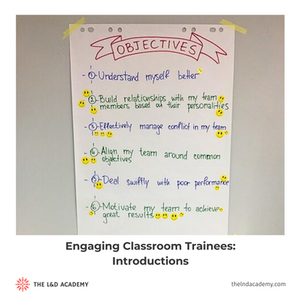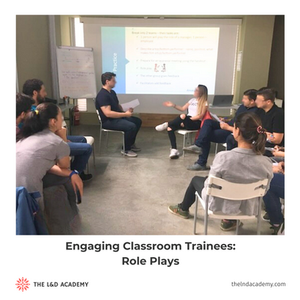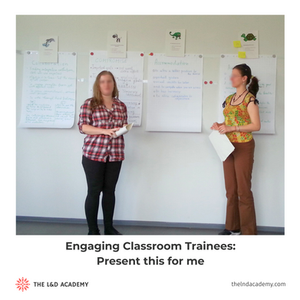This is it – the room has been set up, the slides have been loaded, people are looking up at you with anticipation – the training is about to start. There’s just one problem – the content is super boring!
Fear not, my dear friend. Because even the most boring topic can be turned into an unforgettable learning experience. So let’s dive into some tips on delivering engaging classroom training sessions.

Table of Contents:
Introductions matter
How you introduce yourself and the session matters—it sets the tone for the rest of the session. You can certainly go down the standard route of just announcing the topic and asking everyone to quickly introduce themselves. But let's be honest—that’s boring! Consider making the intro more engaging with the two activities below.
Paper Mixer
Tape a piece of paper to the bottom of the chairs (or just place them on top), with each paper containing a question related to the topic and your training objectives. Once everyone has settled in, tell them to recover the paper and have a mixer where people talk to each other and discuss the questions.

What’s in it for me?
Is the above too bold for you? No problem—ask everyone to stand in a circle, toss a ball to a random person, and ask them to introduce themselves and explain what they hope to get out of the session. Then, they toss the ball to someone else until everyone has had a chance to share.
Alternatively, show the training objectives and ask people to place a sticker next to the ones they find most interesting/valuable/important/urgent. Encourage them to talk with each other and discuss why they selected the ones they did. This not only lets people to get to know each other in a more informal setting, but they are plunged into the training topic from the get-go.
Incorporate interactive activities
There is nothing worse than sitting for a long period of time and having to listen to a trainer. I try to use the 10-20 rule: I talk for no more than 10 minutes, and then the audience talks or practices for 20 minutes. In light of this, how can you make it interactive?
Problem-solving exercises
The best way to learn is to practice and do the work. And the training room is the perfect place to do this in a safe environment where mistakes won’t have real-world consequences. Just make sure the problems you present are relevant and something the trainees can, in fact, solve with the knowledge and skills they currently possess.
Role plays
Pretending to be someone else can be a lot of fun. Combine it with the learning process, and you get role plays. Have a few situations/simulations ready. Give instructions to your trainees and have them practice what you’ve taught them. Studying MS Excel? Have them interact with a coworker where they need to check some info in a complicated sheet. Learning sales techniques? Have them deal with a difficult customer.
Case studies
Have a case study or two at the ready to engage your audience in a group discussion. We often learn so much from others, and this is a great way to get those meaningful conversations going. Not to mention – case studies can keep your audience engaged and make them active participants in the learning process.
Encourage participation and collaboration
We already highlighted how annoying it is to be a passive partaker in a training session. Therefore, it makes sense to turn your trainees not just into active participants but drivers of the training content altogether. Here are some practical ideas you can try.
Present this for me
Sometimes, the content doesn’t naturally call for games, activities, or role-playing. What do you do then? Embrace it! Break your group into smaller teams, have them do some research or discuss a topic, and present back to the group. Not only do you not have to talk through the boring bits, but you are helping them take charge of their learning process and make sense of the infromation.
If you want to take it to the next level, don’t allow them to write words on a flipchart; instead, have them present the content using images or pictograms that you’ve cut out or printed ahead of time. This can be a lot of fun for both the presenters and the listeners.
Brainstorming
Most adult learners attend training because they want to find a solution to a specific problem. Again, embrace this. Instead of giving them the solution, have them discover it through brainstorming and talking to others. We like to call this the “collective genius”. If you tap into it, not only are you making the session more interactive and engaging, but you may also learn something new yourself.
Peer Feedback
The training room should be a safe space for people to try things out and make mistakes. If you want this experience to also be interactive, encourage the participants to share feedback with each other. His means pairing them up, giving them tasks to work through (e.g. role plays), and sharing ideas about how they can improve in the future.

Make it visual
No, we don’t mean to have 200 PowerPoint slides. (As a matter of fact, in our experience, the fewer slides you have, the better!) But you can make the room more inviting and casual by having a colorful visual representation of the agenda (in the form of a road or a river, perhaps?) and use the floor to represent a model.
Employ effective communication techniques
Let’s say that your training topic doesn’t really allow for much interactivity or participation from the audience. Not all is lost, though! It just means you need to step into the shoes of an entertainer… or edutainers, as we like to call them. No, you don’t need to turn into a motivational speaker or a stand-up comedian. But you do need to use effective communication techniques, like storytelling and humor.
Storytelling
People are wired to listen to stories. Use that to your advantage. Instead of explaining how a software feature works step-by-step, tell a story of how this was used wrongly in the past and what the consequences were. Check out the “How To Tell Stories That Get People Talking & Actively Participating in Training” article to find out more.
Humor
Find opportunities in your session plan to share an anecdote, tell a funny story, or point out a self-deprecating behavior. Do be careful, though. You need to know your audience and tailor your humor to them.
Conclusion
How do you keep your trainees engaged? Let us know in the comments down below.
Transforming a dull face-to-face training session into a lively and engaging learning adventure is well within your grasp. The key is to think about your audience first and what kind of experience they will go through – will they be a passive receiver of information or will they be heavily involved and in charge of their learning process?
The ultimate goal of any classroom training is not to inform; people have Google for that. You want to inspire and involve your participants. So, take the 5 strategies above, adapt them to your content and style, and watch your session come to life with energy, enthusiasm and, most importantly, effective learning outcomes. Happy training!



































